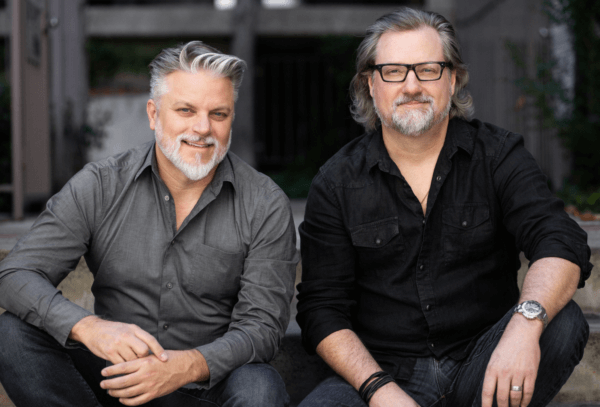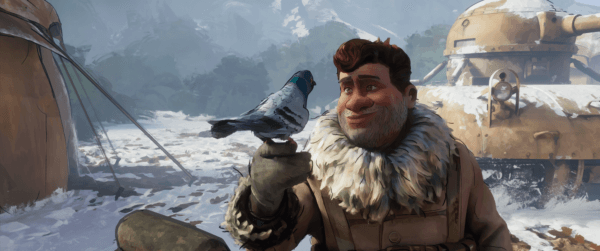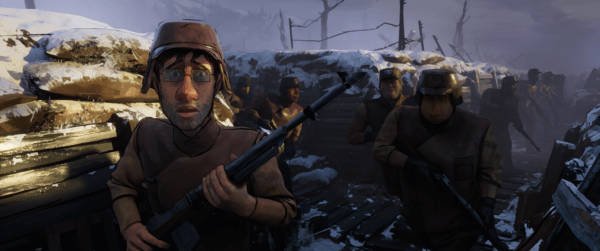WAR IS OVER! A conversation with Oscar winners Dave Mullins and Brad Booker
UPDATE 10/03/2024 – WAR IS OVER! has won the 2024 Oscar for Animated Short Film
WAR IS OVER! The anti-war message promoted by John Lennon and Yoko Ono over 50 years ago is as fresh today as it was when the Vietnam War was raging. The slogan of peace and harmony has been refreshed once more not only by ongoing troubles internationally, but through the power of animation in a new short film directed by Pixar veteran Dave Mullins and produced by Brad Booker.
Set in an alternate reality marred by an ongoing and senseless war, two soldiers from opposing sides engage in an anonymous game of chess assisted by a brave carrier pigeon. As the game unfolds, the narrative builds toward a climactic final move that transcends the chessboard and proves that with war there are no winners.
The short has managed to pull off an incredible feat of making the music and the message central to the film, without turning it into a music video. Whilst the message is driven by the huge personality of Yoko Ono and John Lennon, the short isn’t gimmicky or weighed down by unnecessary Easter eggs to please fans of the artists, instead opting to be its own timeless entity to fit alongside the message.
The film has been nominated for the Academy Award for animated short and Mullins is no stranger to the glare of the awards season spotlight, directing LOU for Pixar which was also nominated for the Oscar and producer Brad Booker is equally battle hardened through the circuit having produced Jorge Guttierez’ Golden Globe nominated The Book of Life. The pair have founded ElectroLeague, a new studio to produce the film.
Collaborating with Peter Jackson’s Weta VFX and under the creative assistance of Sean Lennon, who contributes as a writer, the 11 minute short is not merely a visual spectacle but a vehicle for promoting the message of peace. Through the use of cutting-edge technologies, the film aims to leverage the magic of animated storytelling to inspire audiences and foster a renewed understanding of the importance of harmony.
We caught up with Dave Mullins and Brad Booker to find out how the film came to be.
Can you take me back to the origins of the film, did the song naturally become part of an existing story or was the story devised to amplify the song and the message?
Dave Mullins – It’s a funny story. A friend connected me with Sean Lennon, who needed a director for a music video. Despite my background in narrative work, we clicked over the anti-war message in his parents’ song. Sean wasn’t interested in a typical music video; he wanted to convey the song’s message. In our meetings, we brainstormed a narrative about two factions at war realizing their common ground through a game, using chess as a metaphor. The idea of a carrier pigeon bridging the gap emerged. After a couple of meetings, I penned the script in one night. It was a crazy process.
Brad Booker – Yeah, it stayed very close to what Dave originally wrote, just to give a timeframe of when all this unfolded. The war in Ukraine hadn’t broken out, but tensions were escalating. It was prominently featured in the news media, and you could sense it coming. I believe this heightened our sense of urgency and responsibility. It thrust us into the next few months, eventually leading us to some of the partners who joined the film.
It’s such a shame that the film began with the beginnings of a war which is still ongoing and, and the media is now concentrating on other wars. It takes us back to the original message of the film, which is now 50 years old from a completely different world.
DM – Yes, absolutely. I mean, the idea was that war is over, if you want it. Just the idea that we don’t have to be doing this – there are other ways to resolve conflicts. I get it, I’m not naive, I know that the world is what it is, but I mean, I think with their message is this idea of war’s over, if you want to. It’s an interesting idea. There are other ways of resolving conflict. And this idea of people who think they are completely different from one another – completely against each other, if they just sat down and talked – they would realise they have more in common than they though and could figure out any conflict.
BB – It was also powerful enough to draw Peter Jackson into the project, thanks to the longstanding connection between Peter and Sean from the ‘Get Back’ docu-series. During a weekend spent with Sean, he sent the script to Peter, who immediately was engaged and scheduled a Zoom call for the very next day. Peter brought Claire Olssen and David Conley, the head of Wētā FX, on board as producers—forming a close partnership with us. Peter’s motivation to join the project stemmed from his admiration for John Yoko and Sean, as well as the compelling artistic elements in the script we presented to him. Ultimately, he wanted to be involved because of the art and the script that we showed him. But at the end of the day, he said John and Yoko’s message is more important now than ever, we need to get this out into the world
After that it kind of started falling like dominoes, the next week I spoke with David Conley and we were figuring out how we were going to do this within the budget and the timeframe we had, then later that week, I went to dinner with a good friend of mine who has won two Oscars for Avatar, he’s a visual effects sup and executive producer on the Avatar sequels. Richie Baneham, who I’ve known since our early days at Warne r Brothers. He was astounded by our lineup and suggested we shoot on the Avatar stage. He spoke to James Cameron, and within a few days, we secured seven days on the Avatar stage.
As our project progressed, we showcased our work to Epic Games, utilizing the Unreal Engine 4. The Special Projects Group at Wētā FX had designed a real-time pipeline, aligning perfectly with our vision for a stylized form of storytelling. Our innovative use of the Unreal Engine, typically employed for photorealistic elements in games, caught the attention of Epic Games.
As Dave always remarks, it’s as if lightning struck the same tree six times, and we couldn’t be more grateful for the incredible journey and collaborations that unfolded.”
DM – We were the tree. Lightning was good. So it’s a weird metaphor!
Was the performance capture technology used to take away some of the burden of having to animate crowds of people in the battle sequences?
DM – We want to go from script to stage so we want to be able to use Unreal. I mean, in a perfect world, we would have assets, characters, environments, even some lighting, we’d go into stage we would shoot and we’d be able to see a really close approximation of what the scene would really look like with the performance from the actors. Now. We’re both animators and we’ve been animating since the early 90s so we have a massive appreciation for animation and caricature and what animation and animators produce. We were with Jorge Gutierrez (El Tigre, Book of Life, Maya and the Three) the other day, and he described me as an animation purist, he was like “Wait a minute, you use motion, performance capture – what?!” he was like blown away! What’s fantastic about it is that we can get the film up and running swiftly, almost like an advanced layout.
I can believe the hand of the animator is at play throughout, there is a particular moment where the aggressive and battle hardened general sees the message and his face drops. And we see his character completely changes as his mission completely changes. I think there’s something in that which could only really been captured through with the hand of the animator.
DM – Of course, the effectiveness depends on the nature of the project. For instance, in the case of a series, where we’re more focused on series production, we might leverage more of the captured data. However, if we’re doing something that’s a little more designed, you know, the animator’s hand is always going to be a big part of it. As you mentioned, Steve. In the midst of a large battle scene, we prefer not to burden animators with the task of detailing numerous background fighters. Instead, we direct their efforts toward refining performances, ensuring each one is visually stunning. This involves attention to caricature, proper silhouettes, and all the elements that contribute to creating incredible animated performances. Characters like our pigeon, Icarus, in the film had to be animated by hand. So there’s a lot of really beautiful, crafted animation. Every scene was at least lightly touched, if not heavily. So we’re just looking at it as a tool to get the film up quickly. And we want to use as much of it as possible without hindering our pipelines or our timeline.
I am an unashamed Beatles and John Lennon nerd. I don’t know whether or not it was intentional but there’s a slight look of ‘Private Gripweed’ from How I Won the War to the main character, which was obviously played by John Lennon back in the 60s, how many Lennon influences can people see in the film?
BB – As the film’s title suggests, it draws inspiration from John and Yoko. So, indeed, there’s a noticeable influence of John in the character of Winston, coincidentally sharing John’s middle name. It’s a nod to John, but we initially experimented with round glasses for Winston. However, we found two issues with this approach. Firstly, it felt a bit too obvious. Secondly, we had adopted a deliberate design style where Winston’s side featured straight lines and angular shapes, while Abel’s side on the right side of the screen embraced rounded shapes. This was a conscious design choice. Concerning Winston, we felt the initial design was too literal. We wanted audiences to sense the inspiration without making him a carbon copy. He needed to stand as his own distinct character.
DM – And the reference to How I Won the War, I wasn’t aware of it!
BB – We actually used some of the set photos from that. And it found its way in.
DM – My point being, I wasn’t even aware of that until after we had completed the script. It was like, ‘Should we be conscious of how similar this is?’ I asked, ‘Similar to what?’ So, it became a bit of a learning experience for me. However, I want to revisit your earlier comment about the sergeant turns on a dime when they receive the order to stop fighting.
I’m a bit of a gamer and used to run a World of Warcraft guild. Through that experience, I met many people, including a retired colonel from the army who became a good friend. At a certain point in the show’s development, I showed him the film to get his perspective, given his military background. The significant takeaway for him was the portrayal of giving commands in battle. Having given similar orders himself, he expressed gratitude for showcasing that side of it, acknowledging the weight of knowing the risk involved for their soldiers.
This sentiment resonated not only with him but also with my nephew, a Marine, and every veteran we collaborated with on the film. Their profound reactions affirmed that we captured this aspect accurately, and we feel that we got that part of it right.
The design seems to cleverly reflect the lyrics somewhat which might read a little nonsensical out of context to some “So happy Christmas, for black and for white for yellow, and red ones.” I noticed that the uniforms are yellow and red, and the black and white obviously match the chess set. Can you talk me through the intentionality of the design.
DM – A lot of people have noticed that. I have to confess that, yes, it does align nicely. However, for me, the black, white, yellow, and red were about people’s culture and skin colour and like representing everybody. So for me, I always was, you know, we were just really trying to think about how we could represent everybody culturally. Our focus was on cultural inclusivity. That’s why we dedicated considerable time to portraying this “Wait is this World War One?” setting—getting people to ask “whose uniforms are those”. We aimed to make a broader statement about war in general rather than depicting a specific conflict. Although the carrier pigeon contextualised it in World War One, we deliberately avoided tying it to any particular historical event. We worked diligently to ensure that anyone watching the film, regardless of their background, could see themselves represented in the army. While it’s true that people have pointed out the colour symbolism, I can’t claim it was entirely intentional. Nevertheless, it’s another bit of luck that lines up nicely.
BB – we’ve worked on a lot of films and I think that stuff finds its way in subliminally sometimes, you just don’t even realise you’re doing it but there was also a lot of purposeful effort that went into the design and trying to make sure that whoever watched the film didn’t come with baggage, so if a German citizen is watching it and a British citizen is watching they aren’t bringing relics of the past and that this is its own thing you know, this own world this new world that we’ve created that’s kind of World War One like but not World War One because we want people, to like Dave said, to view it as an every war
Has the has the song itself been remixed? It sounds clearer in parts.
BB – Yeah, we actually brought a guy named Paul Hicks who was the lead engineer at Abbey Road for many years and we mixed the whole thing on an Atmos soundstage, so the whole thing’s mixed and Atmos. They had a nearfield Atmos mix, which means kind of home video version of it. But he came in and we did a proper theatrical version, basically broke John and Yoko and the chorus and all the different instruments. We broke all that stuff out in the separate elements and placed it in the movie theatre. You know, in 3D. It’s an object based sound system. So yeah, that was Paul Hicks, he’s done a lot of remixes on other Beatles and Lennon songs so he came on to this one for a day of mixing on the dub stage.
DM – We’re used to hearing the original song which I think was recorded in their apartment, but after Paul added the fidelity I feel like it’s the best version of the song. It’s not changing the song at all. But the first time we heard it in Atmos, I was like, “oh my god, it’s like I’m hearing the song for the first time.” It was really incredible, he did such a great job of it.




